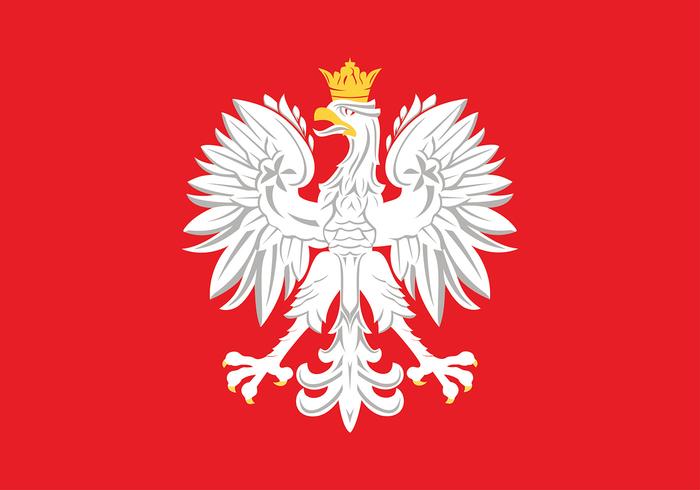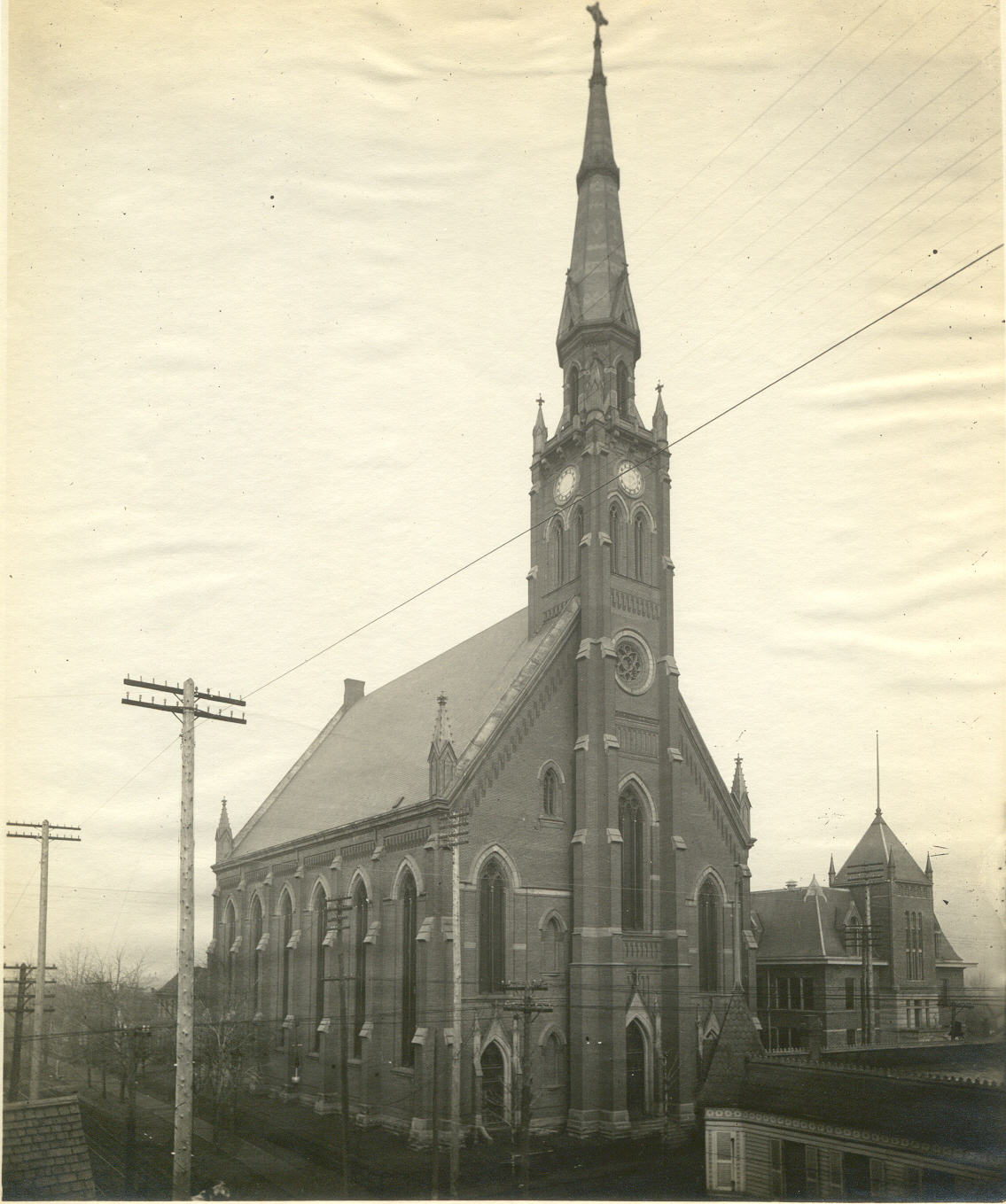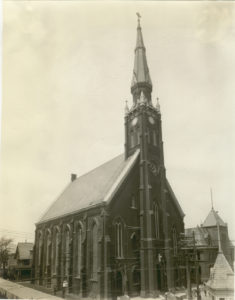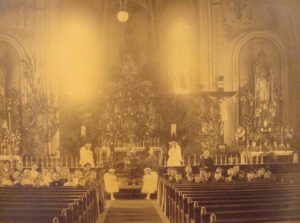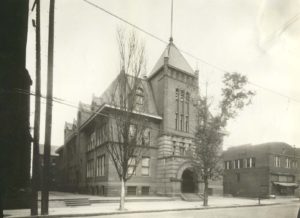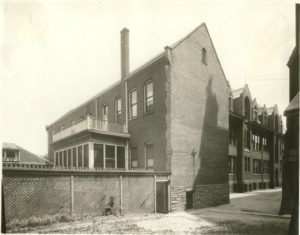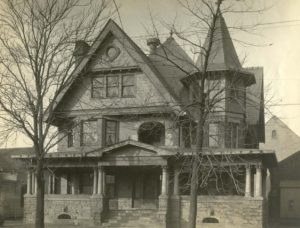St. Anthony Parish
Toledo Polish Churches > St. Anthony ParishSt. Anthony Parish St. Anthony Parish: “You always know where you are by looking for the steeple.” The above reference to the tallest church steeple in the city of Toledo was often said by neighborhood people whose beloved church’s steeple was a towering 250 feet. The roof is 120 feet high, and the church sits on a small hill, making the church a very impressive sight. In 1871, Polish immigrants began to settle in the area now known as Kuhschwanz (“Cow’s tail” in German), just to the west of the German settlement known as Lenk’s Hill. It really was the “Cow’s tail,” as this Polish settlement was literally on the edge of the Toledo city limits. At this time, the spot where St. Anthony Church stands now, was outside the city limits in Adams Township, where many of these Poles farmed the land. The earliest residents of Kuhschwanz lived in the area roughly bounded by Belmont, Detroit, Campbell and Hawley streets. They had to walk about a mile to the east, crossing Swan Creek and the canal bed, to attend services at St. Peter Church ( later called Ss. Peter & Paul) German Catholic Church. When St. Hedwig parish was founded in 1875, the Kuhschwanz Poles attended St. Hedwig, several miles to the northeast. When a sufficient number of Poles moved into the neighborhood, they began to make plans for their own parish. Long-time residents of Kuhschwanz Casimir Czarnecki, Michael Golembiewski, Andrew Extejt, Anthony Gomulski, John Katafiasz, Joseph Lisiakowski and others formed a committee to consult with Bishop Gilmour of Cleveland. In the fall of 1881, the bishop told Father Vincent Lewandowski, pastor of Saint Hedwig Church, to buy land for a new church. Father Lewandowski purchased three lots: lots 868 and 870 from Charles and Isabella Griffin of Chicago for $1,100, lot 867 from Mathias and Mary Lawecki for $300; lot 866 was purchased from Valentine and Catherine Nadolny for $900 in 1889. The first three were at the corner of Junction and Nebraska Avenues, and the last was to be the site of the rectory on Nebraska. The frame church was 40 feet wide and 100 feet long, and cost $2,500. Very Reverend F. M. Boff of Cleveland officially opened the church dedicated to Saint Anthony of Padua on November 12, 1882. In the summer of 1883, a 60 foot by 35 foot wooden school building was built for $2,000. Classes started in September 1883, and the school was staffed by the Felician Sisters of Detroit, who served from 1883 until its closing, except for the years 1888-1893 when the Franciscan Sisters were in charge. Father Lewandowski was the first pastor, serving both St. Anthony’s and St. Hedwig’s parishes until 1884, at which time he was replaced by Father M. Orzechowski. By 1889, the wooden church was too small for the 450 families. The trolley line had been extended to the Nebraska and Junction neighborhood. Father Nicodemus Kolasinski moved the rectory to the Nadolny lot at a cost of $ 784. The Panic of 1893 and opposition to the building committee made raising funds difficult. Father Kolasinski was transferred to a Scranton, Pennsylvania parish due to complaints and a lawsuit. Father Felix S, Motulewski from Suwalki, Poland faced an unfinished church and a $25,000 debt. He borrowed money from banks and from his parishioners. The new Gothic-style church with artistically carved altars had a 250-foot steeple, which could be seen from almost anywhere in the neighborhood. The brick church was 92 feet wide and 150 feet in length. Ten pillars supported the 120-foot high roof. The church seated 1,600 people, and cost $95,000. Father M. Zoeller, S.J. of St. Mary’s Church said the first Mass on March 4, 1894, and Bishop Ignatius Horstman of Cleveland blessed the new church on July 15, 1894. Despite turning the old church into four classrooms, the school was overcrowded with 100 children in some rooms. With the debt for the new church, a new school seemed impossible. However, the parish societies cooperatively reduced the debt, and members resolved to build a new school for $50,000 at a meeting in 1899. John Rozek moved the old school to Vance Street, and ground was broken in 1900. Father Motulewski died of Bright’s disease before the new school opened in late 1901. Fifteen Sisters lived in the new convent building. An immigrant at the age of 12, Andrew Suplicki was the son of Joseph Suplicki and Catharine Ratajczak of Zlotwo, Posen, Prussia (Poland). Ordained in 1893 in Cleveland, Father Andrew J. Suplicki first served as an assistant at St. Anthony Parish; he returned as pastor in 1901. He led the completion of the school and building of the rectory in 1906. Architect Dowling designed a large brick home with a wrap around porch for the pastor, three assistants and many guests for $16,000. At the turn of the century, Father Suplicki pioneered the community involvement of his parishioners through a civic and political club. He purchased and printed Kuryer Katolicki, a weekly newspaper edited by A. Surdel and later by Revered F. S. Legowski and Louis Szyperski. On a national level, Father Suplicki was vice president of the Polish Catholic Union and of the Executive Committee of the 1903 Polish Congress. On May 3, 1903, the Knights of St. Casimir society sponsored a trip to Detroit for over 500 Toledo Poles. As the people were saying goodbye to relatives and friends and boarding the train, the Pan-American Flier of the Grand Trunk Railroad thrust into the crowd without warning, killing and injuring many. The passengers tearfully returned home. Father Suplicki protected the people who filed for damages from dishonest opportunists. Five years later, the Polish community started the tradition of “Polish Day” at a summer resort on Maumee Bay. All the Polish parishes, societies and organizations participated in the celebration as well as local and national speakers. As World War I approached in 1917, “Polish Day” events focused on unity and war preparedness. The people generously bought Liberty Bonds, volunteered with the Red Cross and war relief, joined the American Armed Forces and the Polish Army. The community organized a magnificent patriotic parade of all ages and meeting at the Memorial Hall on May 30, 1917. The parish supported its doughboys of World War I, welcomed them home and mourned those who died in France. The veterans organized the Tony Wroblewski American Legion Post in honor of the first Lucas County soldier to die in 1918. Father Suplicki had a bad cold in November 1921, which turned into pneumonia. He died on December 28, 1921; over 3,000 people attended the funeral rites. Reverend Francis S. Legowski, a son of Saint Hedwig, became pastor and the most influential person in the history of Kuhschwanz. Appointed pastor in February of 1922, Father Legowski first announced the formation of the Nativity of Christ Parish and plans for an Educational and Social Center. He started a school tuition program of $1.00 registration per child and 10 cents per week. Next, the parish purchased the property at 1325 Nebraska Avenue for $10,960 at a sheriff’s sale. This was to be the center; a day nursery was inaugurated. On November 4, 1923, the parish entertained General Joseph Haller, commander of the Polish Army during World War I, at a public reception in the school auditorium. In the first decades of the twentieth century, people worked 12 to 14 hours a day in factories and shops and on the railroads. Mothers did all the household chores by hand. Everyone went to bed early, tired and weary; there was little time for recreation or entertainment. The family stayed at home most of the time, and they were closer, understood each other and depended upon each other. Entertainment was homemade. Families grew vegetables and flowers in their backyard gardens; fall was the time to can fruits, jams and vegetables. The family attended Mass together on Sunday morning, and the afternoon was the time for family gatherings and sports. The immigrants and the children of immigrants valued their new freedom, and they belonged to a multitude of patriotic, uniformed and old country societies. During the 1920’s, neighborhood leaders attempted to bring together the parish and civic organizations to better the community. While many parishioners had no jobs and no money during the Great Depression, St. Anthony did not pay the interest on its debt. Nevertheless, on November 13, 1932, the Most Reverend Bishop Karl J. Alter joined in the celebration of the Golden Jubilee of the parish. Father Anthony Majewski of St. Ladislaus Parish in Hamtramck, Michigan along with Reverend Joseph Kucharski and Al Sobczak celebrated the Mass. Reverend Anthony Pietrykowski, John Lubiatowski and John Labuzinski conducted Vesper Services. The community gave a banquet in the school auditorium, the Dramatic Club presented a Minstrel Show, the school children staged a play, and the Entertainment Committee sponsored a bazaar, dinner dance and card party. What a joyous celebration for the entire parish! The people of St. Anthony’s and their priests suffered during World War II. They said goodbye to their men and prayed for them and for peace and wrote to them. They sacrificed through rationing and less income; they bought war bonds. Monsignor Legowski was busy ministering to his people and with his civic commitments, i.e., Department of Ohio American Legion Chaplain, the Toledo Industrial Peace Board (the future Labor Management Committee), Lucas County Board of Public Assistance, War Chest Drive of Greater Toledo, control committee of the Toledo Council of Social Agencies and many Legion positions. After the war, the young men came home, went back to work and got married. Most new couples moved further south and west in Toledo to buy their own modern homes. Enjoying the highest standard of living in United States history, parishioners had increased economic security, worked fewer hours and enjoyed more leisure time. The old societies declined, and national organizations, such as Boy Scouts, Girl Scouts, Catholic Youth Organization and Parent and Teacher Clubs, increased their membership. At St. Anthony’s, the men belonged to the Holy Name Society with its subdivision of National Council of Catholic Men. Men backed the Scouts, CYO, hobbies and handicrafts in the school, sports for members and children, picnics and social outings. Women belonged to the Ladies’ Organization, which included the National Council of Catholic Women for unifying women across the country, the Altar and Rosary Society for serving its church, the Parent and Teacher Council for promoting educational and leisure interests of children, the Poor Souls League for praying for deceased parishioners and the Confraternity of Christian Doctrine for promoting the word of God. Changing neighborhood demographics resulted in Nativity Parish becoming a Mission of St. Anthony Parish; Nativity Church was permanently closed in 1982. St. Stanislaus Parish became a Mission Parish of St. Anthony in 1977; both St. Anthony and St. Stanislaus were permanently closed in 2005. St. Anthony Rectory is currently the Padua Center, a community services center. The school was closed in 1973, and the building was razed in 2008. Parish records for St. Anthony are located in the Diocesan Archives.
Pastors of St. Anthony Parish: Reverend Vincent Lewandowski (1881-1884) Reverend M. Orzechowski (1884-1887) Reverend E. M. Slowikowski (1888-1889) Reverend Nicodemus Kolasinski (1889-1893) Reverend Felix S. Motulewski (1893-1901) Reverend Andrew J. Suplicki (1901-1921) Reverend Francis S. Legowski (1922-1968) Reverend Albin A. Radecki (1968-1972) Reverend Zygmunt J. Pitula (1972-1977) Reverend Jerome Nowakowski (1977-1981) Reverend Gerald J. Robinson (1981-1989) Reverend Stephen J. Marjoros (1989-1994) Reverend Gerald E. Kneuven (1994-2005) First Baptism: Andrew Chmielewski, son of Bartholomew Chmielewski and Antonina, born Nov. 5, 1882, baptized Nov. 12, 1882 by Fr. Vincent Lewandowski, godparents Adam Chmielewski and Rose Ignasiak First Marriage: Teofil Sobieralski and Frances Kujawa,witnesses Frank Korpecki and Joseph Kujawa Married on Nov. 13, 1882 by Fr. Vincent Lewandowski First Funeral Mass: Frank Rombkowski, a stillborn child, on Nov. 23, 1881 Vincent Brandek, first adult funeral, killed by a train, on Apr. 26, 1883 Out of 23 burials in 1883, 19 were of children. Patron Saint: St. Anthony of Padua, 1195-1231, feast day June 13 Born Fernando Martins de Bulhoes in Lisbon, Portugal on Aug. 15, 1195, Anthony entered the community of Canons Regular of St. Augustine near Lisbon, to pray and study Scripture and the writings of the fathers of the church for eight years. Upon viewing the bones of Franciscan martyrs from Morocco, he was inspired to join the Order of Friars Minor to spread the Gospel in Morocco. The newly named Anthony contracted a severe illness in North Africa. On his way back to Portugal, his ship was blown off course, and he lived a quiet life in Italy. One day, Anthony was asked to preach at an ordination because no one else had prepared. To everyone’s astonishment, he was a gifted and charismatic speaker. Saint Francis appointed him to the ministry of preaching. Many times, he offered Mass outdoors to accommodate crowds of up to 30,000 people. He worked to reform morality by preaching against luxury, avarice, tyranny and hatred. Anthony was also noted for miracles and the conversion of heretics in southern France. He helped debtors and the imprisoned. In 1231, he died at the age of 36 at the Poor Clare monastery at Arcella. The feast of Saint Anthony is June 13. He was canonized less than one year after his death. Many Catholics pray to St. Anthony for help in finding lost things. A novice, who planned to run away, stole Anthony’s prayer book. He prayed for its return; the novice saw an apparition demanding return of the book. He returned the precious book to Anthony. Prayer to Saint Anthony: Dear Saint Anthony, you are the patron of the poor and the helper of all who seek lost articles. Help me to find the object I have lost so that I will be able to make better use of the time I will gain for God’s greater honor and glory. Grant your gracious aid to all people who seek what they have lost – especially those who seek to regain God’s grace. Address: 1416 Nebraska Avenue (at Junction) Toledo, Ohio 43607 Bibliography: “Saint Anthony,” Hanley, John and Scalia, Rosalia, A History of the Diocese of Toledo. Strasbourg, France: Editions du Signe, 2009 1882 + 1957: Diamond Jubilee of St. Anthony’s Parish, Toledo, Ohio “St. Anthony of Padua,” www.catholic.org Clerus Toletanus: A Directory of Clergy, Religious Communities and Parishes of the Diocese of Toledo in America, 1910 to 2011, vol. 1 no. 1 |
